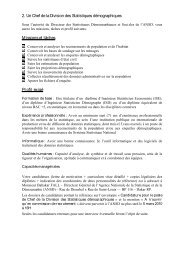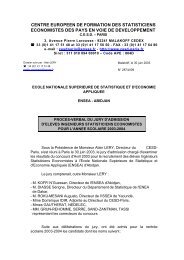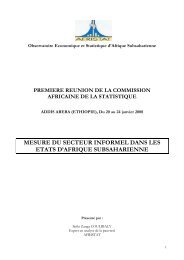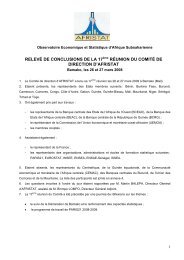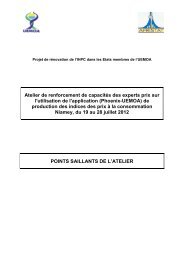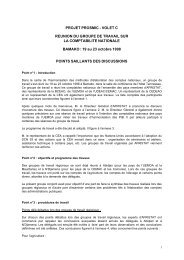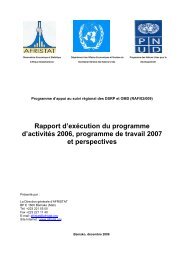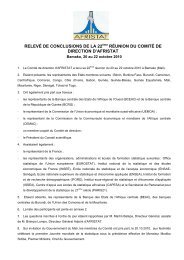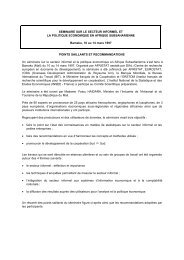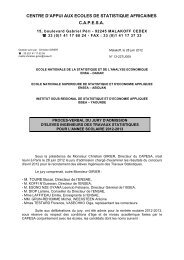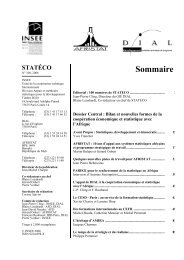Global Purchasing Power Parities and Real Expenditures - Afristat
Global Purchasing Power Parities and Real Expenditures - Afristat
Global Purchasing Power Parities and Real Expenditures - Afristat
Create successful ePaper yourself
Turn your PDF publications into a flip-book with our unique Google optimized e-Paper software.
Glossary 203tice, general administration, <strong>and</strong> the protection of theenvironment.Communication. Includes expenditures on postal services<strong>and</strong> on telephone <strong>and</strong> telefax equipment <strong>and</strong> services.Comparability requires participating countries to priceproducts that are identical or, if not identical, equivalent.Pricing comparable products ensures that differences inprices between countries for a product reflect actual pricedifferences <strong>and</strong> are not influenced by differences in quality.Two or more products are said to be comparable if eitherm Their physical <strong>and</strong> economic characteristics areidentical orm They are sufficiently similar that consumers are generallyindifferent between them.Compensation of employees. All payments in cash <strong>and</strong> inkind made by employers to employees in return for workdone by them during the accounting period. These paymentscomprise gross wages <strong>and</strong> salaries in cash <strong>and</strong> in kind,employers’ actual social contributions, <strong>and</strong> imputed socialcontributions.Component. A subset of goods <strong>and</strong>/or services that makeup some defined aggregate.Consistency. The requirement that the prices collected bycountries are consistent with the prices underlying theirestimates of final expenditure on GDP. In most cases, thismeans that they should be national annual purchasers’prices. At the basis of a comparison is the identity—expenditure= price multiplied by volume—<strong>and</strong> volumes areobtained by dividing expenditures by prices. Using pricesthat do not correspond to those used to derive the expenditureswill result in the volumes being either underestimatedor overestimated.Construction. Includes the construction of new structures<strong>and</strong> the renovation of existing structures. Structuresinclude residential buildings, nonresidential buildings, <strong>and</strong>civil engineering works.Consumer durables. Durable goods acquired by householdsfor final consumption (that is, those that are not used byhouseholds as stores of value or by unincorporated enterprisesowned by households for purposes of production);they may be used for purposes of consumption repeatedlyor continuously over a period of a year or more.Consumption of fixed capital. The reduction in the valueof the fixed assets used in production during the accountingperiod, resulting from physical deterioration, normal obsolescence,or normal accidental damage.CPD method (country-product-dummy method). The multilateralmethod used by the ICP to obtain transitive PPPsat the basic-heading level through regression analysis. Ittreats the calculation of PPPs as a matter of statistical inference,an estimation problem rather than an index numberproblem. The underlying hypothesis is that, apart from r<strong>and</strong>omdisturbance, the PPPs for individual products withina basic heading are all constant between any given pair ofcountries. In other words, it is assumed that the pattern ofrelative prices of the different products within a given basicheading is the same in all countries. It is also assumed thateach country has its own overall price level for the basicheading <strong>and</strong> that it is that which fixes the levels of absoluteprices of the products in the basic heading for the country.By treating the prices observed in the countries for the basicheading as r<strong>and</strong>om samples, the PPPs between each pair ofcountries <strong>and</strong> the common pattern of relative prices can beestimated using classical least-square methods. The methodallows sampling errors to be estimated for the PPPs.Deflation. The division of the current value of some aggregateby a price index—described as a “deflator”—to valueits quantities at the prices of the price reference period.ECP (European Comparison Program). The ICP regionalprogram for Europe carried out under the auspices of theUnited Nations Economic Commission for Europe. It isorganized by Eurostat, the OECD, the Interstate StatisticalCommittee of the Commonwealth of Independent States,<strong>and</strong> the State Committee of the Russian Federation onStatistics.Education. Includes expenditures by households on preprimary,primary, secondary, postsecondary, <strong>and</strong> tertiaryeducation; also includes expenditures by government oneducation benefits <strong>and</strong> reimbursements <strong>and</strong> on productionof education services.



